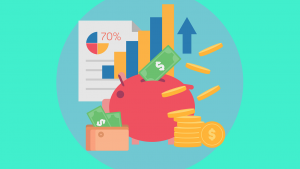Now that the holidays are over, do you feel like you’ve been buried under an avalanche of debt? If so, that avalanche has probably been building up for a while, and it just took the last few months of spending (or even the last few years of tough times) to really shake it loose and make you feel crushed under the weight. So if you are feeling helpless, and like you’re never going to be able to start saving, what can you do? You might want to try two proven strategies to pay down that debt and then turn around and start saving: turning that avalanche of debt into a debt snowball, so you can then build a wealth snowball.
What Is a Debt Snowball?

It’s no secret that you can’t start saving, and therefore start building wealth, if you’re saddled with debt. But, if you’ve got multiple debts that you’re struggling to pay off every month, it can be overwhelming trying to figure out how to start paying them off. Well, there are different routes you can take: for example, some choose the “debt avalanche” strategy, meaning they prioritize putting money towards high-interest debts in order to save money. This strategy might end up saving you money in the long run, but for many people this strategy of focusing on the long game offers little in the way of more short-term motivational milestones.
So if you find yourself stumbling when it comes to a more long-term debt pay-down strategy, maybe what you need is a more rewarding approach. That’s where the debt snowball comes in: with this method of repayment, you throw all of your money at your smallest debt first, then when that debt is paid off, you use the money you’ve freed up to start paying off bigger debts – kind of like rolling a snowball down a hill. The advantage to this method? What you lose out on in terms of savings on interest payments, you will gain in motivation and satisfaction, as you see your debts (even if they’re the smallest ones initially) eliminated one by one.
How to Start Building Your Debt Snowball
Building your debt snowball is pretty straightforward, and can be broken down in a few steps:
- Make a list of the debts that you’re paying off each month (leaving out your mortgage, if you have one) and then sort them from smallest to largest.
- Start with the smallest balance you have and throw as much money as you can at it, while only paying the minimum amount on your other, larger debts. This is probably the trickiest step in the process, as you’ll have to crunch some numbers to figure out how much you can afford to pay towards your smallest debt, while still having enough to pay the minimum on your other debts, and still have enough to comfortably get by every month. Some experts recommend having a $1000 cushion of savings before beginning this method, but at this point, you’re not worrying as much about saving; this part of the plan is all about getting rid of the debt you have so you can get to the saving stage!
- Once you’ve paid off the smallest balance, and you’re basking in that satisfactory glow of having rid yourself of a debt, take that motivation – and the money you’d been putting toward your smallest debt – and put it into paying off your next smallest debt. Don’t be tempted to use the money you’ve freed up by paying off that debt for something else, or even to save it, keep the momentum of your snowball going!
- As it says on your shampoo bottle: lather, rinse, repeat: keep repeating these steps until you reach your largest debt, and then are eventually debt free!
To give an example: let’s say all of your minimum payments on your debts equal $800 a month, and that’s what you’re currently paying – just the minimum. And let’s say, for your smallest balance, the minimum is $50 – try throwing some extra money at that smallest balance until it’s quickly paid off. Then you’ve got an extra $50 plus whatever extra you were paying towards that balance to put towards your next largest balance, which has a minimum payment of $100. Once that debt is paid off, you then have $150 to put towards your next biggest debt, and so on and so on, making sure to never go below that original $800 per month, no matter how much smaller your debts get. And before you know, you’re knocking off debts left and right!
What Is a Wealth Snowball?
Building your debt snowball does take discipline, but once you see it rolling and rolling, and you start paying off debt after debt, you’ll be so motivated by that rewarding sight that you’ll keep going. But once you’ve got those debts paid off, what then? It’s time to use that motivation and discipline to get the most out of the money you’ve freed up.
Get Rich Slowly founder J.D. Roth puts it this way: “I know a lot of people who have gotten out of debt, and once they do they’re kind of lost,” he says. “They don’t know what to do with their money next. So they go out and they start spending again, and it’s kind of like losing weight … they get into the same problems they used to have where they’re spending too much.”
The solution? Focus on building your wealth snowball. Basically, instead of putting that $800 in the example above towards paying off debts every month, take that amount and save it. What you do with it will depend on your personal needs, but many experts suggest doing more with it than simply letting it sit in a low-interest savings account. You should find ways to save that have tax advantages, or that allow you to build up compound interest.
Again according to Roth, “Start building a wealth snowball where you’re socking the money away every month in a retirement account, preferably, because they carry tax advantages. But if not retirement accounts, then in investment accounts where you’re getting returns on your investments, and these returns can compound over time, creating this wealth snowball that’s similar to a debt snowball.”
How to Start Building Your Wealth Snowball
What financial experts want you to know about building your wealth snowball is that, while it might feel difficult, or even unattainable, to consistently save money, the principle behind it is actually super simple: you have to spend less than you earn. Yup, that’s it – and once you’ve paid off debts that becomes much easier. But according to Roth, paying off your debts is great, “But debt reduction is an outcome and not a habit…Better instead to focus on the habit that leads to debt reduction. That habit is saving. That habit is creating a gap between your earning and spending.”
In other words, once you’ve gotten into the habit of finding the extra money to pay off those debts with your debt snowball, keep the ball (or snowball!) rolling, and continue to find ways to put that same amount of money – or more – aside. For example, try cutting your spending in small ways (after all, every little bit helps!), and using your money wisely:
- Reevaluate your recurring expenses, like all of those subscriptions
- If you eat out or have takeout more than once a week, considering cutting it down to once a week
- Work out at home instead of paying for a gym membership
- Cut the cable cord and go streaming
- Look for cheaper cell phone and internet providers
- Pay attention to how you use your credit card, making sure you’re only spending what you can fully pay off each month, and avoid buy now, pay later arrangements. Even better, try to stick to cash as much as possible – you’ll be less likely to impulse buy.
- Buy used or refurbished when you can
- Use energy efficient light bulbs
- Cook in bulk, and freeze your leftovers
- Brew your own coffee instead of buying overpriced coffee drinks every day
- Remember that you don’t need to be rich to save: put aside whatever you can afford, whether it’s $200 a month, or $10 a month!
To sum up: to build your wealth snowball: first, get yourself debt-free. Then, take the money you were putting toward debt payment, and put it into tax-advantaged retirement accounts like a work-sponsored 401(k) or your own IRA like a Traditional or Roth IRA, because of the power of compound interest: the more you save, the more you earn. Finally, when you’ve gotten better at the habit of spending less, try throwing an extra $25 a month into your savings, and slowly increasing that amount over time. In addition, if you get a big bonus, tax rebate, or other windfall, consider putting around 90% aside, leaving the other 10% for a little guilt-free spending.
The Numbers Behind Retirement
If you’re looking ahead to retirement – and you probably are if you’re focused on saving! – we wanted to give you a quick look at what Mr. Money Mustache calls “the shockingly simple math behind early retirement,” just to give you an idea of what saving a little extra can mean for you. So, this is what experts say – if you save:
- 10% of your income, you’ll need to work 50 years to retire
- 20% of your income, you’ll need to work 37 years to retire
- 35% of your income, you’ll need to work 25 years to retire
- 50% of your income, you’ll need to work 17 years to retire
- 70% of your income, you’ll need to work 8.5 years to retire
Now, no one is saying you need to save 70% of your income! But those numbers are very interesting, and should give you an insight into where your savings can take you. For now, though, if you’re feeling crushed by the weight of debt, just start where you are. Focus on digging yourself out by rearranging your life a little bit so you can start building your debt snowball – then, once that snowball is gaining momentum and is steamrolling over your debt, don’t stop! Keep the momentum going so you can start building your wealth snowball, and can eventually reach your financial goals – and man, that will feel good!
